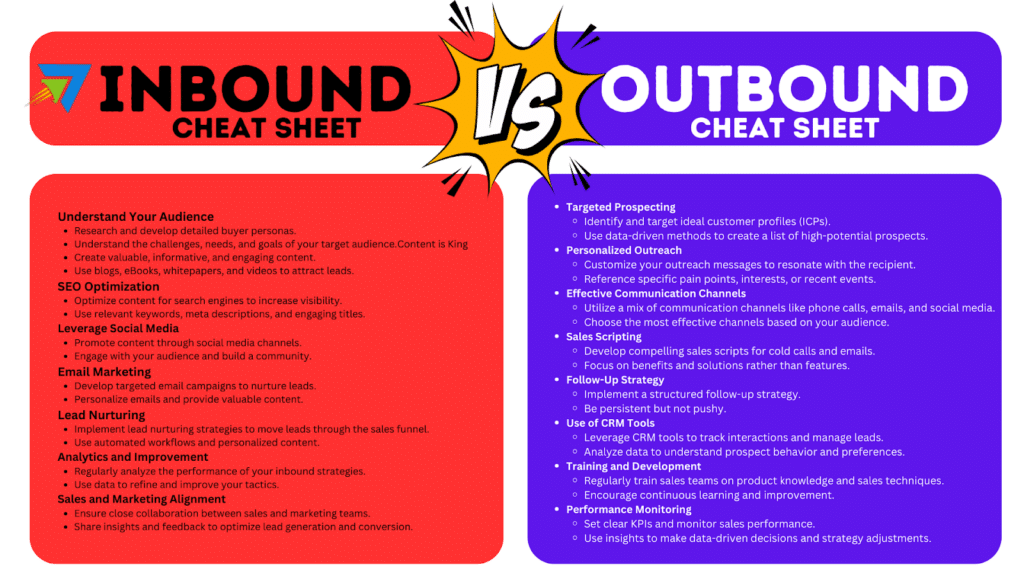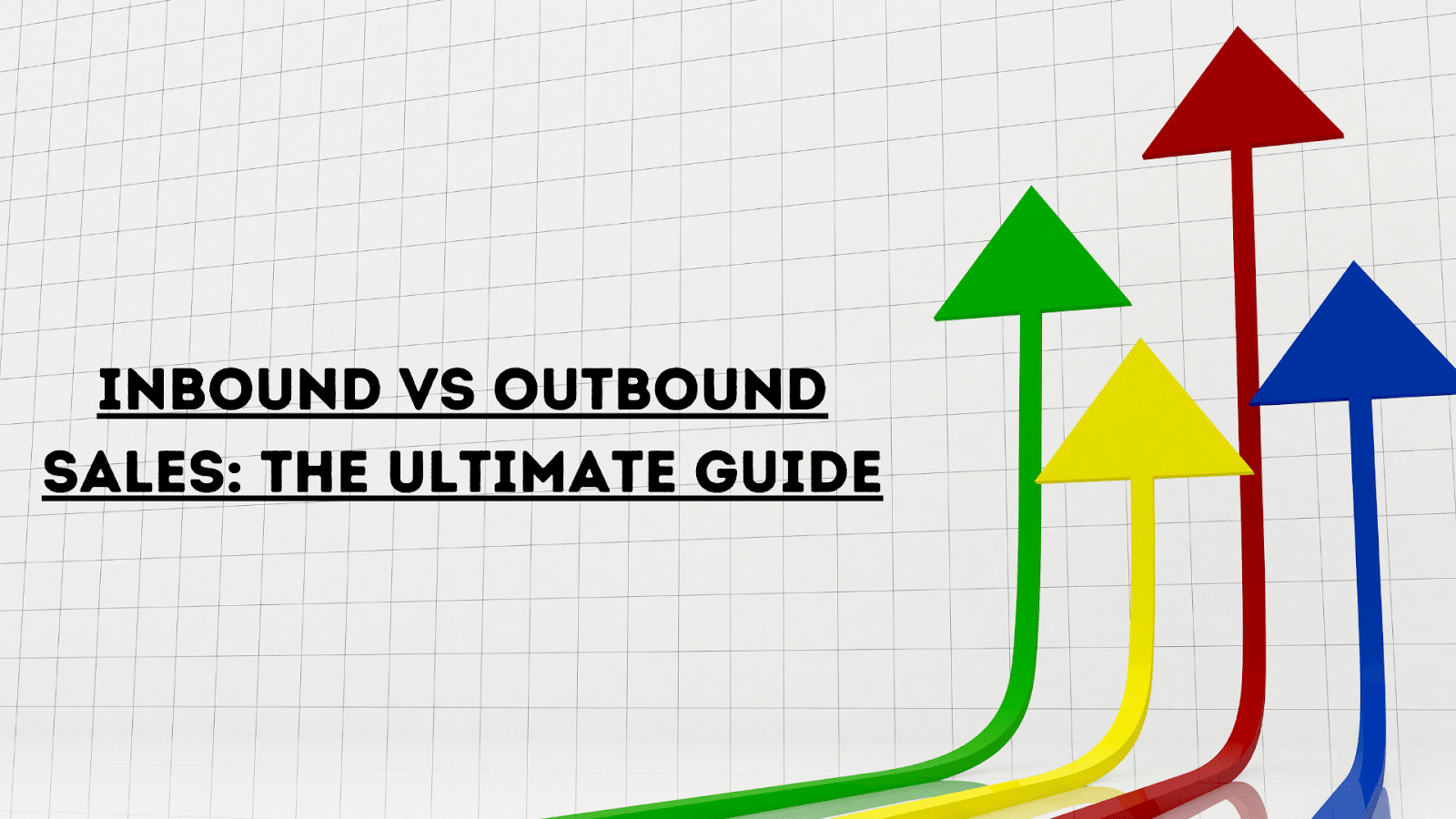Inbound vs Outbound Sales: The Ultimate Guide
Inbound and outbound sales strategies represent two pivotal frameworks for driving business growth. With inbound sales focusing on attracting prospects through valuable content. Outbound sales utilizing direct outreach. It’s important to understand the core differences between these approaches.
Let’s now differentiate the difference between Inbound and Outbound sales. Interestingly, 68% of inbound marketers believe in the effectiveness of their efforts. This is a stark contrast to the 48% in the outbound realm. This statistic is only the tip of the iceberg to the differences of types.
What are Inbound and Outbound Sales
Inbound and outbound sales represent two main approaches to driving sales growth. While they have some similarities, their strategies, techniques, and goals differ.
| Inbound Sales | Outbound Sales |
|
|
Key Differences Between Inbound and Outbound Sales
Knowing the differences between Inbound and Outbound
- Initiation of Contact: Inbound sales interactions are initiated by the prospect. This is through content engagement. Meanwhile outbound sales are driven by direct contact from a sales representative.
- Channels Used: Both strategies leverage diverse channels. Content creation to cold calling, inbound focuses on pulling customers through valuable materials. over pushy outreach.
- Engagement Levels: Inbound buyers tend to be more receptive at contact stages. This is given their existing content interaction. This is contrasted with outbound targets who often have little brand awareness.
- Cost Effectiveness: By attracting engaged prospects, inbound sales can be more cost-effective. This is compared to manually chasing and qualifying outbound leads.
Recognizing these differences naturally leads us to explore appropriate strategic applications. One can then tailor sales strategies for each sales approach.
Specific Differences between Inbound VS Outbound Sales
| Aspect | Inbound Sales | Outbound Sales |
| Initiation of Contact | Prospects initiate contact through engagement with content. | Sales representatives initiate contact directly with prospects. |
| Channels Used | Focuses on content creation, SEO, social media, and other methods to pull customers. | Employs cold calling, emailing, event prospecting, etc., to push products towards customers. |
| Engagement Levels | Prospects are generally more receptive and invested due to prior interaction with content. | Targets often have little to no prior brand awareness, making engagement more challenging. |
| Cost Effectiveness | More cost-effective in the long term due to attracting engaged prospects. | Can be costlier due to the resources required for chasing and qualifying leads. |
| Lead Quality | 59% of marketers report higher quality leads from inbound methods. | 16% of marketers find outbound methods provide higher quality leads. |
| Suitability | Better suited for businesses with longer, complex sales cycles, especially in B2B settings. | More effective for businesses with short sales cycles or transactional purchase models. |
| Buyer Readiness | Leads are often more informed and closer to a purchasing decision due to prior research and engagement. | Requires more effort in educating and nurturing leads to bring them closer to a purchasing decision. |
When to Use Inbound vs Outbound Sales
Companies often wonder what sales strategies they should focus on. The best approach depends greatly on the context of your business. While inbound has grown rapidly in recent years, outbound retains an important strategic role.
Inbound Shines for Long, Complex Sales Cycles
Inbound marketing has seen immense growth.
In such cases, buyers conduct extensive research before committing. Inbound content helps educate buyers early on and builds familiarity with your brand. This ability to attract and engage buyers suits complex sales journeys.
Outbound Excels for Short Sales Cycles
While inbound effectiveness has grown remarkably, outbound retains strengths in key areas. For transactional sales with shorter decision cycles. Outbound sales suit better. The direct outreach of outbound allows for promoting time-sensitive offers. Outbound calls-to-action can also help close prospects who need that final nudge.
Blend Strategies Based on Buyer Personas
Your ideal customer personas should determine whether you emphasize inbound or outbound tactics. For price-sensitive personas that require education early on, inbound suits their longer decision-making. But product-focused buyers may appreciate quick outbound pitches.
Analyze your personas and blend both methodologies to map your sales processes. Tailoring of sales should be done onto their buying behaviors. A strategic balance between inbound and outbound is better than an either-or approach.
Advantages of Inbound Sales
Inbound marketing is on the rise. It allows customers a springboard for engaging with the business. This astounding impact underscores inbound sales’ exceptional strengths.
1. Cost-Effective Growth & Credibility
By drawing prospects through valuable content inbound sales offer cost-efficient acquisition. Compared to outbound sales, this allows greater pipeline growth. Simultaneously building awareness and credibility through content makes closing complex, high-value sales easier.
2. Supporting the Buyer’s Journey Every Step
Inbound sales content aligns with how B2B customers prefer to research purchases. This allows secured leads to enter sales interactions better informed. This makes them better and prepared to buy. Outbound strategies often force sales conversations prematurely.
While inbound sales clearly shine, maintaining balance is necessary. Appreciating outbound sales’ vital strengths is needed for further growth.
Unique Advantages of Outbound Sales Strategies
Inbound sakes approaches generate higher value prospects. However, outbound sales play an equally important role. This is through their unique advantages:
1. Precise Targeting Based on Ideal Customer Profiles
The manual prospecting of outbound sales ensures concentration on the highest value targets. This is as per predetermined ideal customer profiles, lending accuracy to sales pursuit.
2. Immediate Prospect Feedback & Reduced Churn
Cold calls and targeted advertising enable instant prospect feedback. This helps validate product-market fit early on. Direct buyer conversations also reduce churn through personalized sales relationships.
Outbound sales are needed for quick sales and for targeting higher target leads.
Best Practices for Inbound Sales
With In bound’s exceptional lead quality advantages, optimizing its implementation is pivotal.
Adopt a Four-Step Methodology
The key steps are:
- Identify challenges and questions from your client base
- Connect with prospects by creating content addressing these needs
- Explore prospects’ goals through continued value addition
- Advise prospects on solutions once buyer readiness is high
Strategic Marketing and Sales Alignment
Productive collaboration ensures marketing and sales ensures. That generated leads are well-qualified and sales-ready. Shared design of lead qualification protocols and service level agreements help facilitate this.
Best Practices for Outbound Sales
1. Leverage Sales Enablement Tools
Sales enablement platforms provide vital data. Personalize outreach and engage elusive prospects, leading to higher response rates.
2. Employ Qualification Frameworks
Methodically qualifying outbound prospects using buyer lifecycle stage. Also consider likelihood of close, and deal value ensures profitable pursuit.
3. Learn Consultative Closing Skills
Leading outbound prospects into sales conversations requires nuanced consultative education over aggressive pitching. Veteran sales coaching helps master this.
With outbound competencies complementing already robust inbound capabilities. The potential of integrating both approaches is exponential.

Integrating Inbound and Outbound Sales
Debates continue on whether inbound or outbound sales reign supreme. However, data shows leveraging both in a cohesive framework amplifies results.
Dedicating as little as six hours weekly to social media management generates lead growth. This exemplifies how integrated sales strategies outperform isolated deployment of either approach.
Uniting Complementary Strengths
Inbound provides inbound credibility and conversions. This is with outbound direct targeting and instant feedback for the best of both worlds.
Optimizing Lead Qualification
Joint lead qualification protocols ensure both strategies. They feed the most sales-ready prospects to reps, creating an elite pipeline.
Fusing inbound and outbound sales sets the stage for immensely impactful omnichannel strategies. Using both accelerate growth.
Frequently Asked Questions
Still have questions about optimally integrating inbound and outbound sales? Here are answers to some common queries:
How do these strategies impact customer experience?
Inbound sales foster positive experiences through helpful content engagement. This is while outbound interactions are more company-driven. Integrating both meets customers on their terms.
Can small businesses effectively use outbound sales?
Absolutely. Through goal-oriented lead lists and clearly-defined ideal customer profiles. Small biz outbound initiatives can realize tremendous success.
How does sales digital transformation affect this integration?
Digital advancement bolsters inbound content effectiveness for complex products. But blended with targeted offline outbound tactics, integrated sales strategies remain future-proof.
Conclusion
Understanding the core differences between inbound and outbound sales methodologies is important. With this businesses can strategically leverage the strengths of both approaches.
Rather than limiting yourself to either inbound or outbound, try an integrated framework.
Dedicate resources to building a robust inbound content engine, attracting high quality leads. Complement this with precisely targeted outbound strategies to accelerate your most promising prospects. An omnichannel blend meets buyers however they choose to engage. The debate shifts from “either-or” to “when-and-how” to harmonize inbound and outbound sales.



